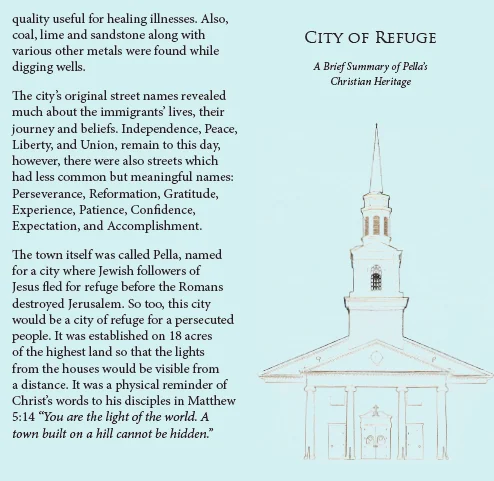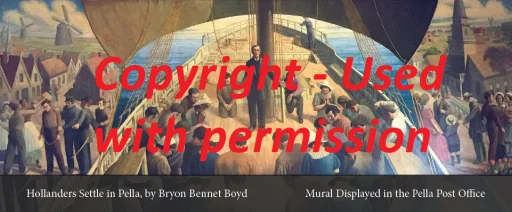Often it is told that the reason Scholte and others left Holland to emigrate to America and settle in Pella was the lack of freedom of worship. One issue at the forefront of the controversy was the mandatory singing of hymns under the hierarchical governance of the church.
This story goes back before 1773 when a new Psalter hymnal replaced the long-held Psalter by Petrus Dathenus. Then in 1807 a collection of many unscriptural hymns was added without ecclesiastical approval. (p13) Under King William I, the church was brought under the state authority and several liturgical rules were introduced including the mandatory singing of these hymns. Many felt these went against the teaching of scripture.
Hendrik Peter Scholte, the founder of Pella, was a powerful and popular preacher and an outspoken proponent of the historic doctrines of the Reformed church in Holland. He was deposed from ministry in part because of his opposition to the mandatory singing of the hymns from this hymnbook. (p113) Several other pastors and churches were also cited for their refusal to sing from the state-sanctioned hymnals. Here are some of their stories.
In one of the opening events of the Secession of 1834, Henry De Cock was deposed from ministry at his church in Ulrum. Because of his arrest and trial, many were stirred to the point that soldiers had to be called in to prevent worship services from being disturbed and hymnbooks from being publicly burned. One prominent accusation was that he had written a sympathetic introduction to a booklet in which the author, Jacobus Klok, strongly objected to the use of so-called evangelical hymns and De Cock also expressed agreement with Klock’s views. (p108)
Anthony Brummelkamp was a young preacher in Hattem where the congregation was used to singing at least one hymn during regular worship service. Yet, he had conscientious objections and later wrote: “I had been aware for some time already that the hymnbook which was introduced into the church in 1807 is both in spirit and tendency in conflict with the Reformed doctrine… I understood very well that by not using it I would bring upon myself the hatred of the establishment. I thought, however, that I had to obey God rather than man.” The Dutch Reformed Church was already concerned with his practice of baptism, not allowing non-members to be baptized. When he abandoned the mandatory singing of the hymns, they seized the opportunity to depose him on October 7, 1835. (p120)
Even after his deposition he continued his ministry and instituted many congregations in the province of Gelderland and Overijssel. Preaching was illegal for the Secession preachers since they were outside of the state church, so he often conducted services in the open air, standing on a chair in the yard of a farm or in a barn. Whenever he was caught, he was required to pay a fine, ultimately amounting to the loss of many thousands of guilders.
After the opening events of the Secession, as Simon Van Velzen entered the ministry, he wrote a letter presented at his very first Classis meeting urging them to adhere to the Three Forms of Unity. All in attendance were silent until he said, “silence lends consent” and asked them to sign the letter. Many spoke up and refused to sign until someone suggested that this business be discussed further at meal time. One of his colleagues pulled him aside and let him know they were very upset with him but he would protect him for they were going to through him down the stairs. (p125) During the meal, one minister faced Ven Velzen, removed his scarf, and shouted that “he would rather have his throat cut than subscribe to the Canons of Dort.” Later, a committee called on him and sought to discuss the content of his appeal but had the motive to ask about his views regarding the singing of hymns during worship. Van Velzen stated that psalm singing should be the norm, he found some hymns objectionable, but some spoke to his heart, so he had suggested singing some of these better hymns. The committee reprimanded him for discussing these issues with his congregation. After this, his elders decided to sing at least one hymn each service. Though they did not want to sing the hymns, they did not want to get their pastor into trouble. This continued to bother him and on November 15, 1835 he announced that he would no longer include hymns in the worship service. (p127) He informed the provincial board and shortly after they suspended him from office on December 9, 1935.
Nearly a year later he was scheduled to preach and conduct several liturgical elements in Tjalleberd. During the opening prayer the distant sound of approaching drums was heard, after the prayer he saw a gentleman and an officer with his detachment of soldiers. They ordered the assembly to disperse immediately but Van Velzen protested that Scripture exhorts believers not to forsake the assembling together. As he proceeded with the service, the soldiers forced the people out with rifles and bayonets, leaving benches overturned and one handicapped man fallen to the ground. After trying to reason with the officer, he fled to a nearby house where most of the church members had gathered. They hoped to celebrate the Lord’s Supper but the elements were back in the barn with the soldiers, so he proceeded to administer a baptism. This service was broken up as soldiers entered the house and chased them to the street. Still determined, the congregants went to another house for the installation of a new Deacon. Before this was completed, the soldiers marched in to disperse them. Finally, they arrived at a fourth house and had just enough time to conduct the wedding before the soldiers drove them out and all departed for their own homes.
Van Velzen went to the new Deacon’s house to stay the night but found that soldiers were quartered there. The owners of the home soon discovered that the soldiers were plotting kill him in the night. A crowd gathered outside and began to throw bricks, the soldiers awaited a break-in, but at the same time the gentleman and officer in charge entered and stopped their plans, offering protection to those in the house. The crowd slinked away and the next morning Van Velzen was secretly escorted out of town. He was later required to pay 100 guilders.
Rev. Lambertus Ledeboer was a stern preacher who had converted because of his deep conviction of sin. Like many others, he made known his strong dislike of the hymns imposed by the national church. While preaching on November 8, 1840, he demonstrated this displeasure by throwing the hymnbook off the pulpit. When someone tried to pick it up and hand it back to him, he said, “Leave it there, we’ll bury it later.” After the service he did. (p312)
Frans Gezelle Meerburg was also thrust into the conflict over the hymns as he was called to Almkerk, a church which had experienced controversy three years earlier. One member who opposed the hymns made a regular practice to put on his stovepipe hat as a form of protest and refused to sing whenever the hymns were announced. After other members joined him, the previous minister tried to deal with this by calling in the police to forcibly remove the man for disturbing the worship service in this way. Meerburg sought a more diplomatic solution choosing to sing from the hymnal at the end of the service, giving members the option to leave before the hymn was sung. This worked for a while but after six months he was burdened and decided to stop singing hymns altogether. He found the inclusion of these hymns to be a violation of his conscience. This was soon brought to the attention of the authorities and he was deposed on November 24, 1835.
Through these stories and events, you can see the prominence of the issue regarding hymnals. For those involved, the primary issue was the conflict with the underlying doctrines and that violated scripture. Both pastor and congregants sought to hold to the teachings of scripture and believed those were best taught in the historical doctrines expressed in the Canons of Dort, which had been removed from the confessions by the king. The church leaders who opposed the Seceders also understood their motivation. One wrote, “We shall certainly deal with Gezelle, that hypocrite. I believe with you…that in the long run the faction will rage itself to death. Those sermons in the open air will cease by themselves, for who wants to have catarrh and rheumatism out of pure love for the Synod of 1618 and 1619?”
Those involved in the Secession had a deep conviction for the Bible and the teachings summarized in their creeds, commonly called the Three Forms of Unity. This included the Heidelberg Catechism, the Belgic Confession and the Canons of Dort. The King kept the first two, but the Canons of Dort were removed. This confession was crafted 200 years earlier at the Synod of Dort, held in the South Holland town of Dordrecht. You will find a map with this town in the Vermeer Windmill museum in Pella. Today, many in Reformed churches still believe and confess the Canons of Dort. Others outside the Reformed church hold to these teachings which are commonly called the Doctrines of Grace.
The Canons of Dort were drawn up to answer and clarify the testimony of the Bible regarding controversial teachings on the way in which believers receive the benefits of Christ. The controversial teachings put forward by the Theology professor, Jacob Arminius, were found to be false and the document presented both a positive statement of scripture as well as answers to many objections found in his teaching. In short it emphasized the role of God in our salvation and assures us that we cannot earn our own salvation but must depend completely upon God and His unmerited grace to save and sustain us.
References:
- Much of this content was taken from A Goodly Heritage, by Cornelis Pronk, page numbers are listed in the article above
- Canons of Dort
- Heidelberg Catechism
- Belgic Confession
 Podcast Episode 2 with Tony Ramsek
Podcast Episode 2 with Tony Ramsek
 Are You Guilty of Bibliolatry?
Are You Guilty of Bibliolatry?
 City of Refuge Pamphlet
City of Refuge Pamphlet
 Persecution Bill
Persecution Bill